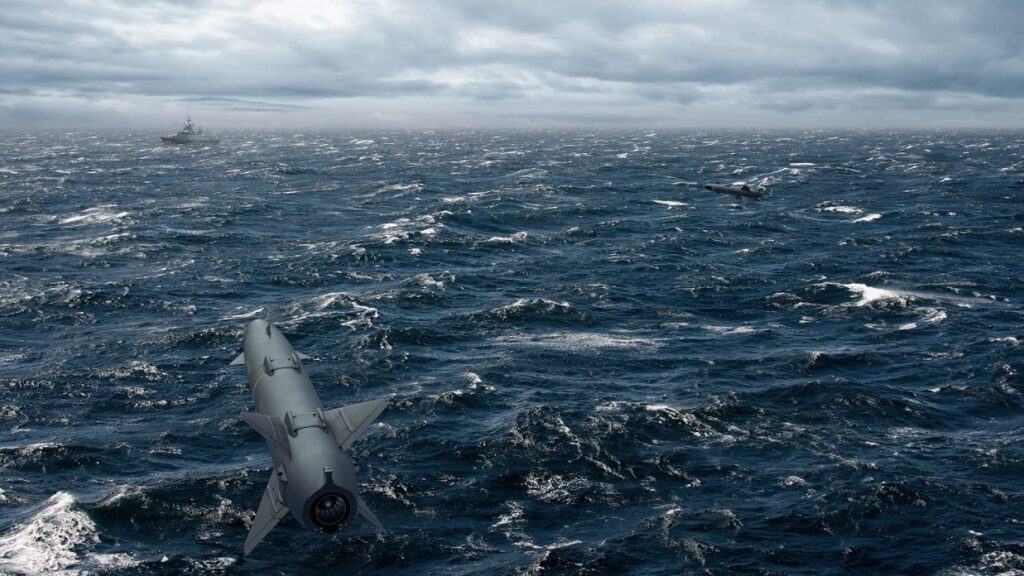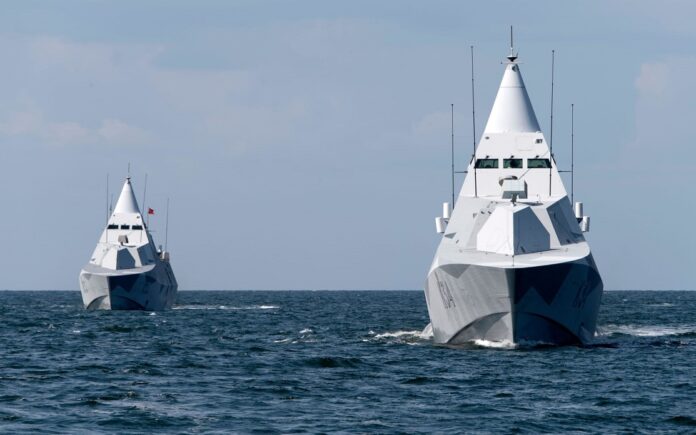The Visby class is the Swedish Navy’s third corvette class, following the Göteborg and Stockholm classes. The ship’s design places a premium on low visibility, a small radar cross-section, and an infrared signature. The class’s first ship is named Visby, after Gotland’s capital city. The class has garnered extensive international notice due to its stealth characteristics.
History
The ships were designed by the Swedish Defence Materiel Administration (FMV) and built by Kockums AB. Construction began in 1996 at Kockums’ Kalrskrona yard. Visby (K31) ‘s lead ship was launched in June 2000 and delivered to the FMV in June 2002 to fit with weapons and combat systems. The second, HMS Helsingborg (K32), was launched in June 2003 and delivered in April 2006. Finally, Harnosand (K33) was launched in December 2004. HMS Visby and Harnosand were officially delivered to the FMV in June 2006. The other hulls are Nykoping (K34), launched in August 2005 and delivered in September 2006, and Karlstad (K35), launched in August 2006. Two corvettes, HMS Helsingborg and Harnosand, were delivered to the Swedish Navy in December 2009. The Swedish Navy has cancelled an option on a sixth vessel (Uddevalla K36).
Design
The Visby was designed to decrease optical and infrared signatures, above-water acoustic and hydroacoustic signatures, underwater electrical potential and magnetic signatures, pressure signatures, radar cross-sections, and actively generated signals.
The hull is sandwiched between a PVC core, carbon fibre, and a vinyl laminate. The use of composite materials in ship hulls has many advantages. Excellent conductivity and flatness result in a low radar signal, while excellent heat insulation reduces the infrared signature and promotes survival in the event of a fire. Additionally, the composite sandwich employed is non-magnetic, reducing the magnetic signature. Composites are also rather stiff than their weight, and less weight equates to a higher peak speed and improved manoeuvrability. The composite material weighs approximately 50% less than steel of comparable strength.

The angular tumblehome design of Visby minimizes its radar signal. One of the inventors, Jan Nilsson, told BBC News Online: “We can achieve a 99 percent reduction in the radar cross-section. Of course, this does not mean it is completely invisible, but it does suggest that we have lowered its detectability “distance.”
General Features
The vessel is equipped with a combined diesel or gas (CODOG) turbine arrangement for high speeds and two diesel engines for low-speed. The engines are connected to two gearboxes, driving two water-jet propulsors. The diesel sustains the vessel at 15 knots, while the turbines kick in when she has to do 35 knots or better.
Technical specifications
| Length overall | 72,7 m |
| Beam, max | 10,4 m |
| Draught at full displacement | 2,4 m |
| Displacement, fully equipped | 650 tons |
| The speed of total displacement | 35+ knots |
| Complement | 43 persons |
It is a flexible surface combatant, designed for a wide range of roles, including but by no means limited to anti-surface warfare (ASUW), anti-submarine warfare (ASW), mine countermeasures (MCM), and patrol.

RBS 15 Anti Ship Missile (Anti Surface Warfare)
Eight Saab Bofors Dynamics RBS 15 Mk2 anti-ship missiles are mounted on the Visby Class corvettes. The RBS15 is a long-range, sea-skimming anti-ship missile with a fire-and-forget capability. It has a tactically flexible trajectory with numerous waypoints and elevations to conceal the launching site, boosting its survival. The RBS15 guidance system is comprised of a GPS/INS navigation system, a radar altimeter, and a terminal phase active radar seeker. As a result, the RBS15 missiles are impervious to countermeasures.
Moreover, several of them can be programmed to attack the target area concurrently from multiple directions, allowing them to penetrate the ship’s air defences more effectively. The RBS 15 Mk2 has a range of more than 200 kilometres and employs active Ku-band radar homing. The missile travels at a high subsonic speed of Mach 0.9 and is armed with a 200kg warhead.

Anti Submarine Warfare
The Visby is equipped with a suite of ASW 127mm rocket-powered grenade launchers, depth charges, and torpedoes. In addition, there are three fixed 400mm torpedo tubes for Saab Underwater Systems Top 45 anti-submarine homing torpedoes.
Mine Countermeasures (MCM)
The Visby transports OCS from the Saab Bofors underwater system (remotely operated vehicles) for mine hunting and the Atlas Elektronik Seafox OCS for mine disposal.
Multi-Ammunition Softkill (MASS) decoy system
MASS has been designed to provide multispectral protection against guided missiles in all relevant wavelengths of the electromagnetic spectrum (including radar, infrared and electro-optical).
Conclusion
Combat advantages of the Visby-class corvette are higher speed for the same power as the conventional metal ship of the same dimensions and more excellent manoeuvrability and shallower draught – both important tactical considerations in littoral waters. In addition, Visby Class Corvette is an ideal coastal warship with its stealth features and ASUW, ASW, MCM, and EW capabilities. However, the limited AAW capabilities of these ships make them vulnerable to air threats. Therefore, within the scope of “Mid-Life Upgrades,” an air defence missile system will be added as a new capability. Furthermore, The RBS15 anti-ship missile system will be upgraded to the latest version and the torpedo system with the new Saab Lightweight Torpedo.
Check out Naval Library App to find out the specifications of the Visby-class corvettes.





